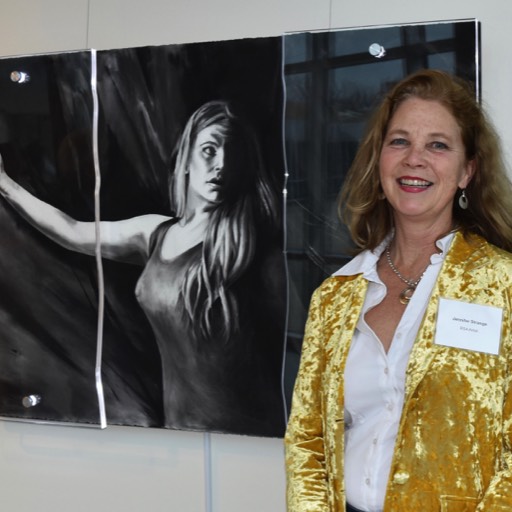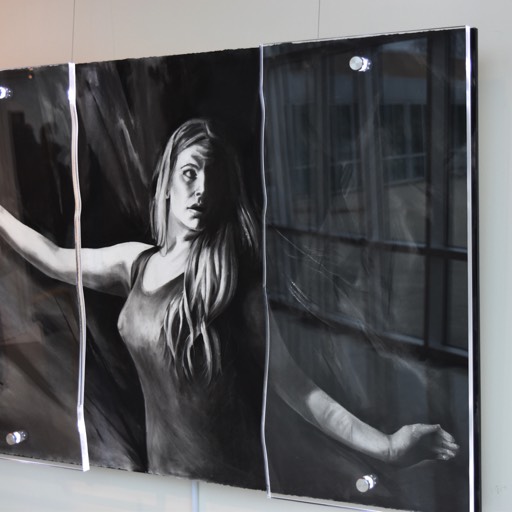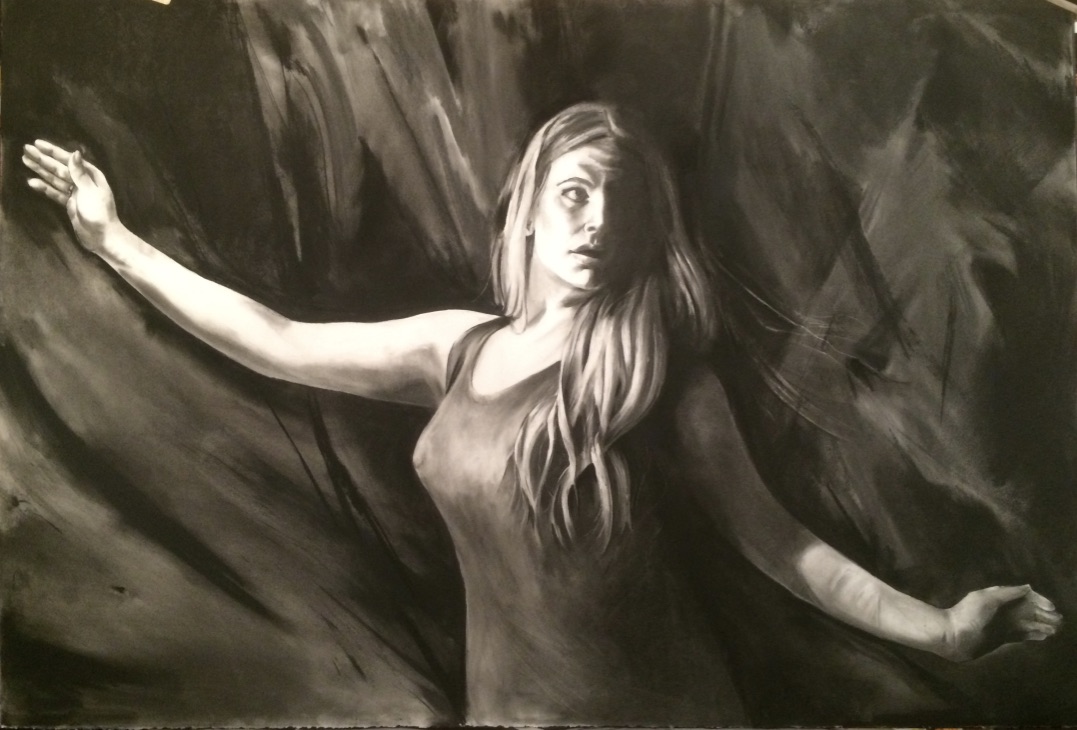
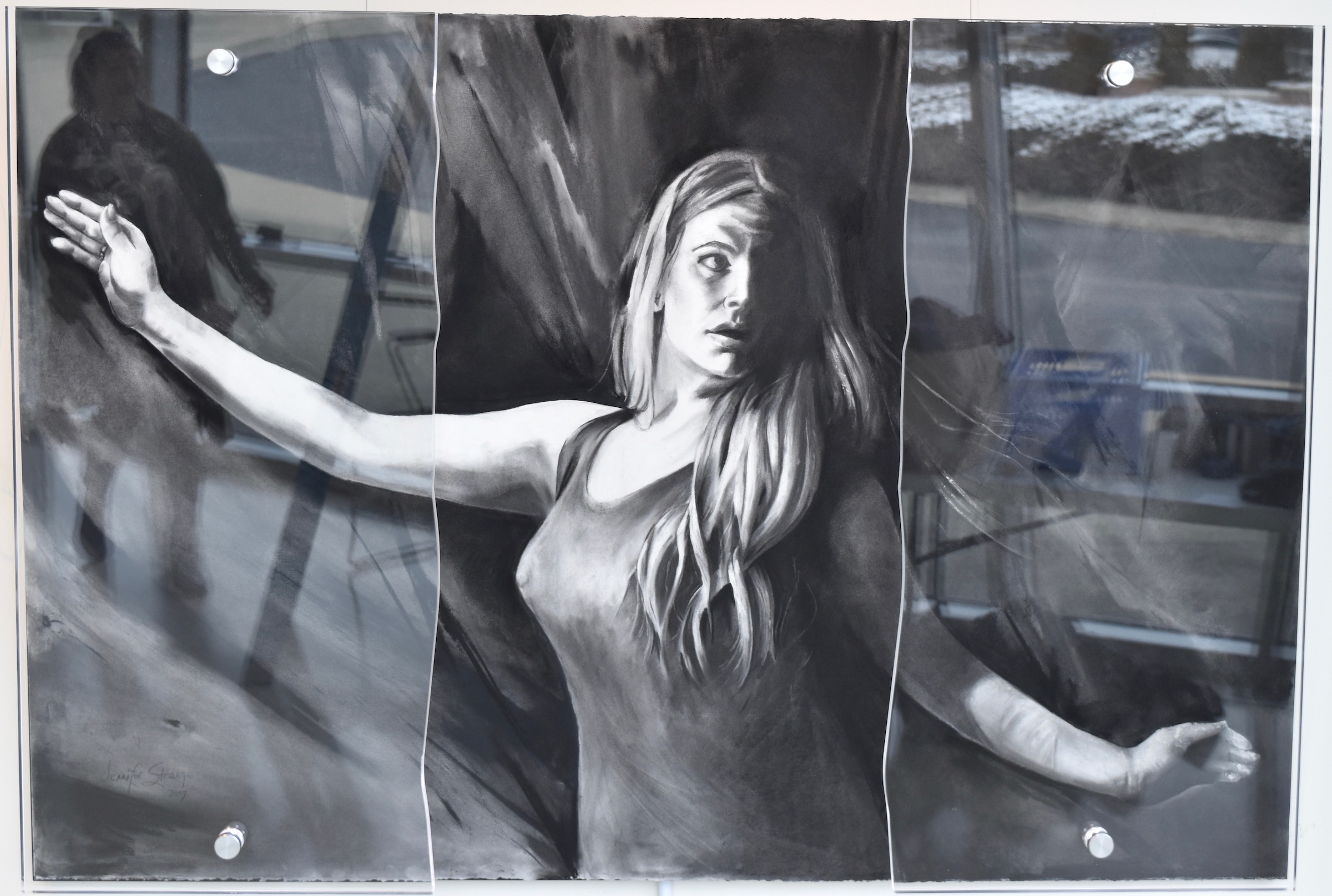
W.A.Y? (Lot's Wife)
34" x 50". Charcoal and Pastel with Dead Sea Salt. Plexiglass and LED lights
Opening Night Video
Artist Statement
I began this project asking a lot of “whys.” Why is this story in the bible? What is the greater lesson? If Sodom was so terrible, why did Lot’s wife look back when she was told not to? Was she feeling loss for her home and two daughters? Was it fear or simply forgetfulness? What is the reason for the metaphor? Now I see Lot’s wife all around me.
Lot’s wife has whispered in my own ear. She has urged me not to remain stuck in the past, fixated upon what-ifs. She has told me to let go of “things.” She has warned that if we allow it, the past can eat away at our soul and keep us stuck or frozen. And while we must be cognizant of our past, both individually and collectively, we must be able to evaluate it honestly. The past can be informative, educational and inspirational OR it can be negative, limiting, even deadly. I have come to understand how our ability to interpret or utilize the past is dependent upon how we envision our future. Lot’s wife has taught me to keep my eyes always looking forward and to endeavor to become my better self, both humanistically and spiritually. She reminds me to approach my future armed with hope and faith knowing that my experiences and knowledge of the past will make me stronger, now, in my present. It our decisions and actions, taken in the present moment, that matter most. Simply put, every moment becomes an opportunity to choose life or death.
I have come to truly appreciate Lot’s Wife, the nameless woman. Perhaps being nameless is the point. It makes it easier see ourselves in her place, facing her future. She has taught me how the past, present and future are all inextricably linked as vehicles for spiritual progression or regression. Metaphorically, we can step into or out of the pillar of salt as we choose. We can move forward to our future or remain frozen and motionless in the past…a very big lesson indeed.
Artist Notes
The art piece consists of a drawing measuring 34” x 50” and is displayed horizontally. The subject matter is a female figure. The drawing focusing on the figure's head, shoulders, torso, and her outstretched arms. Additional elements include two plexiglass panels mounted along the left and right sides of the drawing. The plexiglass panels edges are illuminated by LED lighting.
Composition
The torso and head occupies the central section. Her shoulders face forward, or to the viewers left, and her head is turning back over her right shoulder. The figures right arm reaches upwards to the left edge of the picture plane. Her left arm stretches back to the right edge of the paper. A bright light source emanates from outside of the picture plane and illuminates the forward facing planes of the figure. The planes that fall away plunge into deep shadows. The exaggeration of the highlights and shadows attempt to create a dynamic compositional flow. Symbolically, light represents divinity. The strength of the light verses the dark also represents the starkness of the story and my interpretation of it’s lessons.
In addition to the drawing, there are two plexiglass panels measuring 34” high x 16” each. They are placed one along the left edge and one along the right, leaving the central section exposed. They serve to graphically divide the composition into thirds. The panels are held in place by stand-off hardware; circular metal signage holders. These stand offs are equipped with LED lights hidden under the cap. The LED light flow thru the plexiglass and illuminates the edges of the two panels. This serves to frame the central section of the drawing by create strong vertical band of light There are several motives for this that are explained further below.
Future, Present & Past
The 3 visual zones represent future, present and past reading left to right.
I thought about which way to orient the this ordering. It felt correct to begin with the future, as it is toward a hopeful and positive direction I always strive to take. One may begin a journey by simply finding a road and driving, however one typically has some destination in mind.
Beginning with the first section, on the left this area represent the Future. In particular a future illuminated by divine light. This future is one that is hopeful, who’s aims are good. One that strives for humanistic and spiritual growth. The figure's arm transects this zone and is a strong horizontal shape, but slightly elevated upward to symbolize this reaching for the divine light.
The center section represents the present. It shows the moment the figure, Lot’s wife is in motion, looking back. It is visually active. However, framed by the vertical light along the edge of the plexiglass panels, this movement becomes locked in. The present moment is highlighted as this is where decision and action occurs. This is also the flash when heaven and earth are joined as Lot’s Wife is turned to the pillar of salt.
The final section on the right side represents the past. The drawing fades into darkness moving to the last section along the right edge of the drawing, representing the past. Compositionally, the darkness becomes a heavy shape. Balance, however is achieved in several ways. As the female figure is in the process of turning her head back toward the past, she will be actively directing movement in that direction. Additionally, the strong light being picked up along the figures back stretched arm will pull the eye to the right. Her hand, is low in the picture plane and nearly manikin like. This symbolized the transition from human to pillar. I have encrusted Dead Sea salt onto the drawing at the finger tips and along the arm.
Hard & Soft - Divine Light & Physical Light
There is juxtaposition of hard and soft and physical light and implied light. The drawing is an energetic composition, capturing action in motion. This drawn light source is intended to represent a divine light. This divine light is on many levels a basis of faith. We are often guided by a light we cannot physically see but one that we recognize intuitively. It seems to guide us into the unknown, but to a promise of something good. In contrast, the physical light along the plexiglass panels severs the softness of the form and visually create a harsh edge. In addition to representing the moment when Lot’s Wife is turned to the pillar of Salt, it serves to recognize that life is indeed harsh. Life is difficult. Life can be unfair. We all carry scars and regrets. What makes us better, and allows for personal and spiritual growth is our ability to transcend the harsh reality of life.
Vulnerability
Artist's often travel deep into the human psyche in order to reach for some bit of truth to translate into form. When we do so, we make ourselves vulnerable. We become vulnerable to our own self doubts, our own insecurities, and the judgement of others. But when we believe in something that is important, our fears may be minimized, for we know we have made an honest attempt to convey some authentic truth to share.
I had just installed my drawing in the gallery - two days ahead of the opening. It came together, exactly as I had envisioned over the months of planning. Along the way, I wrestled with an illogical decision not to put the entire drawing behind glass. I could not overcome my desire to leave the central part of the drawing open and exposed. It "wanted" to be kept open, so I kept it that way. I was aware of potential consequences but suppressed the "what ifs."
Once the piece was installed and on the wall, I knew that for many reasons that this was a meaningful and symbolically important aspect of the drawing. It was what it was supposed to be, and yet it was so "exposed". I shoved my worries back and decided not to dwell on it. That night, I woke me up in the middle of the night with feelings of anxiety. I began second guessing my decision. I worried how could I leave the drawing so exposed? "What if something happens to it?" How could I expose it to dust, curious fingers, a multitude of destructive things? My doubts about this decision began to eat away, and then suddenly a new and unexpected consideration appeared in my thoughts.
I realized that this drawing was teaching me a new and important aspect about the power of this story. Because the drawing is displayed with the central portion open, exposed and uncovered, it's physical vulnerability mirrored my own vulnerability as well. I realized that we are exposed not only to the outside world, but to our own truths and our own thoughts. We often fall prey to loops of destructive thoughts or destructive memories. And because the central part of my drawing is uncovered and unprotected, it is exposed to the potential of damage and destruction too. I caught myself "looking back" at my decision but then found a new truth and a new lesson to assure me that vulnerability is a human thing, AND can be a very good thing when "translated" positively. Even though my maternal, protective instincts mingled with a touch of anxiety took over for a moment - in the middle of the night - I now know that exposing ourselves can make us stronger. So I send my girl, my Lot's Wife, exposed and vulnerable into a world threats, real and imagined. And we are both stronger for it.
Lastly, I wish to send my love and sincere thanks to Jane, my beautiful model.
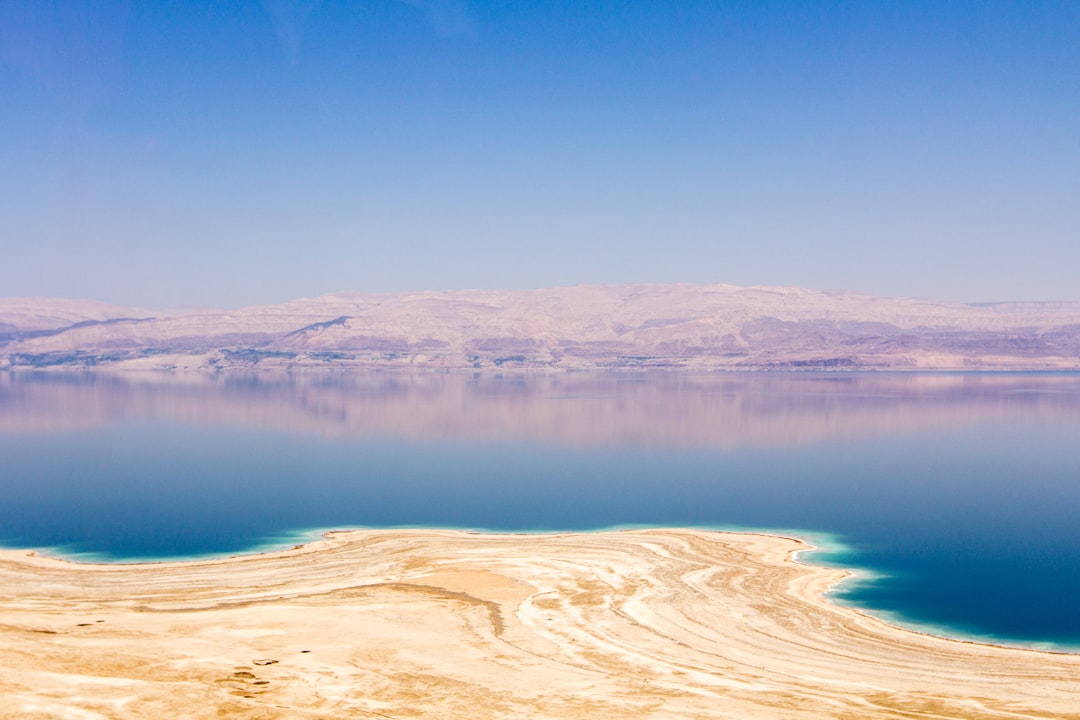
About the Exhibit
The Religion, Spirituality & the Arts Seminar (RSA), a project of the IUPUI Arts & Humanities Institute, invited 12 Indiana artists to explore and expound upon the story of Lot’s Wife during the eighth annual Religion, Spirituality and the Arts Seminar and the accompanying art exhibition. Artists include Stan Blevins, Peggy Breidenbach, Alys Caviness-Gober, Marjie Giffin, A. Paul Johnson, Kasey May, Michael McAuley, William Peacock, Katherine Simmons, Jennifer Strange Keller, Teresa Vazquez, and Kevin Wilson.
In this exhibition, the artists consider questions that delve far beyond the story Lot’s Wife who, as told in Genesis19, turns to see the destruction of Sodom and Gomorrah and becomes a pillar of salt. Did she act in disobedience or out of compassion? What is our responsibility to bear witness? Is looking back redemptive or paralyzing? Might we see contemporary events (mass tragedies, refugees) in the light of this text? Exploring the story through religion, art, poetry, and music, this exhibition will ask questions fundamental to the human experience.
Directed by Rabbi Sandy Sasso, the RSA Seminar explores the varieties of religious experience and understanding. Through seminars led by an interdisciplinary faculty, artists gain the knowledge and inspiration to develop new artistic works. Artists share their creations through exhibitions and presentations to members of the Central Indiana community, including religious organizations, schools, libraries, and community groups.
On March 7, 2019, the first public exhibition of the 2018-19 RSA Seminar’s work will open featuring new works of painting, sculpture, music, and poetry developed by the cohort.
A reception begins at 5:30 p.m. with refreshments and performances beginning at 6:30 p.m. The exhibition will remain on display at the Jewish Community Center of Indianapolis through April 30.
The 2018-19 Religion, Spirituality & the Arts Seminar programming is made possible by a generous grant from Lilly Endowment, Inc. and is offered in partnership with Christian Theological Seminary and the Jewish CommunityCenter of Indianapolis.
The 2018-19 Religion, Spirituality & The Arts Seminar Programming Is Made Possible By A Generous Grant From Lilly Endowment, Inc.
And Is Offered In Partnership With Christian Theological Seminary And The Jewish CommunityCenter Of Indianapolis.

